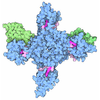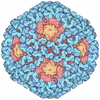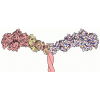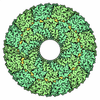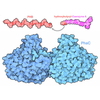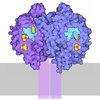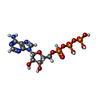登録情報 データベース : PDB / ID : 7p1hタイトル Structure of the V. vulnificus ExoY-G-actin-profilin complex Actin, cytoplasmic 1 Maltose/maltodextrin-binding periplasmic protein,RTX-toxin Profilin-1 キーワード / / / 機能・相同性 分子機能 ドメイン・相同性 構成要素
/ / / / / / / / / / / / / / / / / / / / / / / / / / / / / / / / / / / / / / / / / / / / / / / / / / / / / / / / / / / / / / / / / / / / / / / / / / / / / / / / / / / / / / / / / / / / / / / / / / / / / / / / / / / / / / / / / / / / / / / / / / / / / / / / / / / / / / / / / / / / / / / / / / / / / / / / / / / / / 生物種 Escherichia coli (大腸菌)Vibrio vulnificus (バクテリア)Homo sapiens (ヒト)手法 / / / 解像度 : 3.9 Å データ登録者 Belyy, A. / Merino, F. / Raunser, S. 資金援助 組織 認可番号 国 Max Planck Society
ジャーナル : Nat Commun / 年 : 2021タイトル : Mechanism of actin-dependent activation of nucleotidyl cyclase toxins from bacterial human pathogens.著者 : Alexander Belyy / Felipe Merino / Undine Mechold / Stefan Raunser / 要旨 : Bacterial human pathogens secrete initially inactive nucleotidyl cyclases that become potent enzymes by binding to actin inside eukaryotic host cells. The underlying molecular mechanism of this ... Bacterial human pathogens secrete initially inactive nucleotidyl cyclases that become potent enzymes by binding to actin inside eukaryotic host cells. The underlying molecular mechanism of this activation is, however, unclear. Here, we report structures of ExoY from Pseudomonas aeruginosa and Vibrio vulnificus bound to their corresponding activators F-actin and profilin-G-actin. The structures reveal that in contrast to the apo-state, two flexible regions become ordered and interact strongly with actin. The specific stabilization of these regions results in an allosteric stabilization of the nucleotide binding pocket and thereby to an activation of the enzyme. Differences in the sequence and conformation of the actin-binding regions are responsible for the selective binding to either F- or G-actin. Other nucleotidyl cyclase toxins that bind to calmodulin rather than actin undergo a similar disordered-to-ordered transition during activation, suggesting that the allosteric activation-by-stabilization mechanism of ExoY is conserved in these enzymes, albeit the different activator. 履歴 登録 2021年7月1日 登録サイト / 処理サイト 改定 1.0 2021年11月17日 Provider / タイプ 改定 1.1 2021年12月1日 Group / カテゴリ / citation_authorItem _citation.country / _citation.journal_abbrev ... _citation.country / _citation.journal_abbrev / _citation.journal_id_CSD / _citation.journal_id_ISSN / _citation.journal_volume / _citation.page_first / _citation.page_last / _citation.pdbx_database_id_PubMed / _citation.title / _citation.year / _citation_author.identifier_ORCID
すべて表示 表示を減らす
 データを開く
データを開く 基本情報
基本情報 要素
要素 キーワード
キーワード 機能・相同性情報
機能・相同性情報
 Vibrio vulnificus (バクテリア)
Vibrio vulnificus (バクテリア) Homo sapiens (ヒト)
Homo sapiens (ヒト) データ登録者
データ登録者 ドイツ, 1件
ドイツ, 1件  引用
引用 ジャーナル: Nat Commun / 年: 2021
ジャーナル: Nat Commun / 年: 2021

 構造の表示
構造の表示 ムービービューア
ムービービューア Molmil
Molmil Jmol/JSmol
Jmol/JSmol ダウンロードとリンク
ダウンロードとリンク ダウンロード
ダウンロード 7p1h.cif.gz
7p1h.cif.gz PDBx/mmCIF形式
PDBx/mmCIF形式 pdb7p1h.ent.gz
pdb7p1h.ent.gz PDB形式
PDB形式 7p1h.json.gz
7p1h.json.gz PDBx/mmJSON形式
PDBx/mmJSON形式 その他のダウンロード
その他のダウンロード 7p1h_validation.pdf.gz
7p1h_validation.pdf.gz wwPDB検証レポート
wwPDB検証レポート 7p1h_full_validation.pdf.gz
7p1h_full_validation.pdf.gz 7p1h_validation.xml.gz
7p1h_validation.xml.gz 7p1h_validation.cif.gz
7p1h_validation.cif.gz https://data.pdbj.org/pub/pdb/validation_reports/p1/7p1h
https://data.pdbj.org/pub/pdb/validation_reports/p1/7p1h ftp://data.pdbj.org/pub/pdb/validation_reports/p1/7p1h
ftp://data.pdbj.org/pub/pdb/validation_reports/p1/7p1h リンク
リンク 集合体
集合体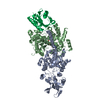
 要素
要素
 Vibrio vulnificus (バクテリア)
Vibrio vulnificus (バクテリア)
 Homo sapiens (ヒト) / 遺伝子: ACTB / 細胞株 (発現宿主): BTI-Tnao38 / 発現宿主:
Homo sapiens (ヒト) / 遺伝子: ACTB / 細胞株 (発現宿主): BTI-Tnao38 / 発現宿主:  Trichoplusia ni (イラクサキンウワバ) / 参照: UniProt: P60709
Trichoplusia ni (イラクサキンウワバ) / 参照: UniProt: P60709 Homo sapiens (ヒト) / 遺伝子: PFN1 / 発現宿主:
Homo sapiens (ヒト) / 遺伝子: PFN1 / 発現宿主: 
 試料調製
試料調製 電子顕微鏡撮影
電子顕微鏡撮影
 FIELD EMISSION GUN / 加速電圧: 300 kV / 照射モード: SPOT SCAN
FIELD EMISSION GUN / 加速電圧: 300 kV / 照射モード: SPOT SCAN 解析
解析 ムービー
ムービー コントローラー
コントローラー







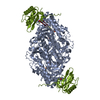

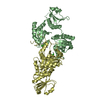

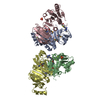
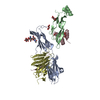
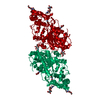
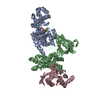
 PDBj
PDBj

